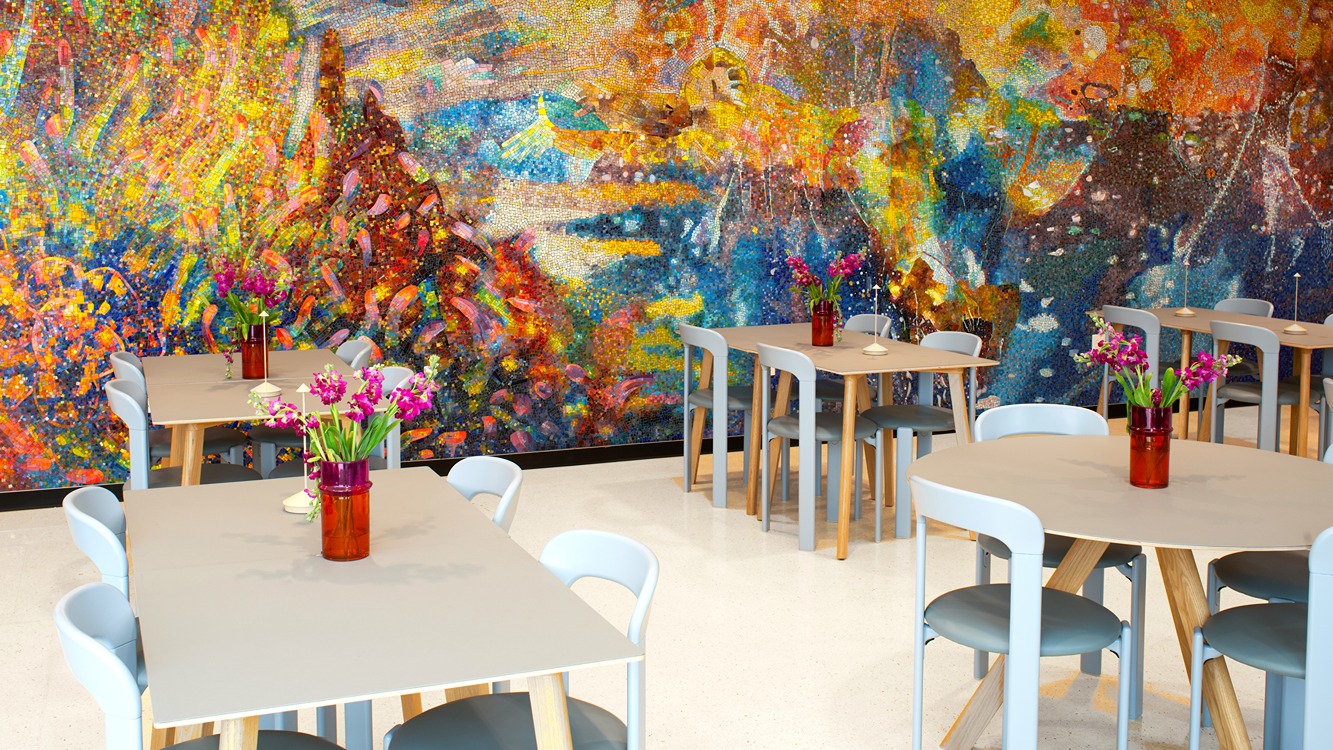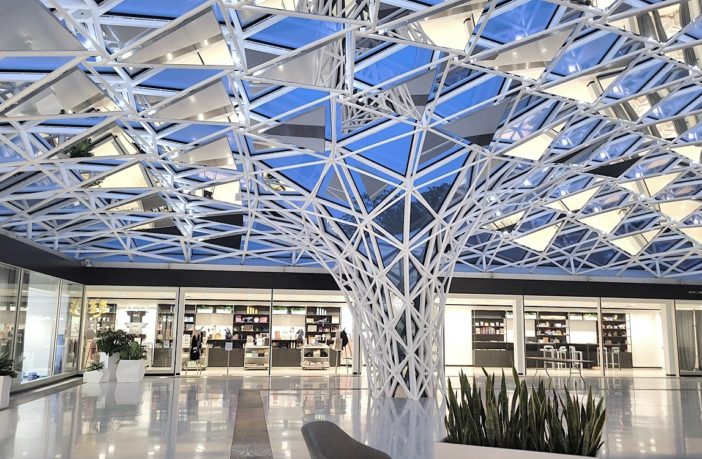The Buffalo AKG Art Museum, which reopened its doors last month after a $230 million renovation and will open the Jeffrey E. Gundlach Building in August, has a new incarnation, something that’s been missing from the establishment from its past 161 years: communal space that encourages the entire Buffalo community to come and engage with art.
Buffalo AKG Art Museum’s Ralph C. Wilson, Jr. Town Square. Image: courtesy Buffalo AKG Art Museum.
The entrance of the Knox Building has been transformed into Ralph C. Wilson, Jr. Town Square, a free open space featuring the monumental art structure Common Sky, by Olafur Eliasson and Sebastian Behmann of Studio Other Spaces.

Chorus of the Deep, Firelei Báez, 2023. Image: courtesy Buffalo AKG Art Museum.
Patrons can visit the Auditorium, the building’s 2,000-square-foot M&T Bank Gallery that’s currently installed with the interactive Mirrored Room; peek into Cornelia café to ingest Chorus of the Deep, an afrofuturistic glass tile mosaic by Firelei Báez, and immerse themselves in classes and workshop held in the building’s five new state-of-the-art classrooms. Performances are now held on the museum’s restored great lawn.
Patrons who venture beyond the communal space and into the museum’s main building can see works by Black artists from the museum’s permanent collection, which includes Icarus by sculptor Richard Hunt; Street Music by painter Norman Lewis and a self protrait by painter Horace Pippin.
“When I was a kid in grade school, I used to take classes here and art constantly has provided opportunities for me,” says Roscoe C. Henderson III, who is on the AKG’s Board of Directors. “I learned to take in different ideas and thoughts and to not be scared to confront my own beliefs.”
It’s that very mindset that could help change the landscape of Buffalo. As the second most populated city in the state, approximately 85 percent of Buffalo’s Black residents live in several neighborhoods located east of Main Street—known as Buffalo’s East Side—making it one of the most racially segregated cities in America. Roughly 43 percent of children, more than 25,000 in the city, live below the poverty line, according to the Center on Budget and Policy Priorities. An adult in the City of Buffalo is almost twice as likely as an adult in the Metro area to be without a high school diploma.
Henderson shared how a study from the Crystal Bridges Museum of American Art revealed that when kids are exposed to art, there is a significant increase in their academic performance.
Fellow AKG board member Kevin Robinson explains how the AKG is more attainable than ever before. “It’s saying, ‘Hey, this is your community asset, come and experience who we are and what we are about,” he shares.
“The museum has been intentional in its effort to reach out to the public to show a different face, that it’s not just an ivory tower that’s only access accessible to some. The idea is to bring down the barriers and to create an open forum for everybody.”

“Harriet Tubman” of The Freedom Wall, Edreys Wajed, 2017. Courtesy Buffalo AKG Art Museum/Amanne Media.
Of course, getting to the AKG’s West Side location isn’t easy for everyone. That’s why the institution was on the right track when it commissioned The Freedom Wall in partnership with the Niagara Frontier Transportation Authority in 2017.
There are 28 portrait panels located on the East Side’s Michigan Avenue and East Ferry Street that celebrate great civil leaders and social justice activists. It features the work of John Baker, Julia Bottoms, Chuck Tingley and Edreys Wajed, who painted Harriet Tubman’s portrait.
“It was a privilege to be a part of such a historical project,” Wajed shares. “Being an artist, it was my duty to lend my expertise and talent to capture her likeness for this outdoor museum where people in our community can come to and learn.”
While these efforts won’t end all the problems that plague the city, they are small steps to encourage the eradication of the invisible barrier that’s kept the city so divided.
“Being a connector that encourages activities for youth that often don’t get opportunities or access on the other side of Main Street and nurturing relationships with individual artists and organizations is a role that I cherish,” Henderson exclaims.
Richardson concurs. “The end game is truly making this place a public institution and not just a place for the few. I think the museum is doing that. This is the beginning of the new era of the AKG and we’re headed in the right direction.”
Visit the Buffalo AKG Art Museum website for more information.



